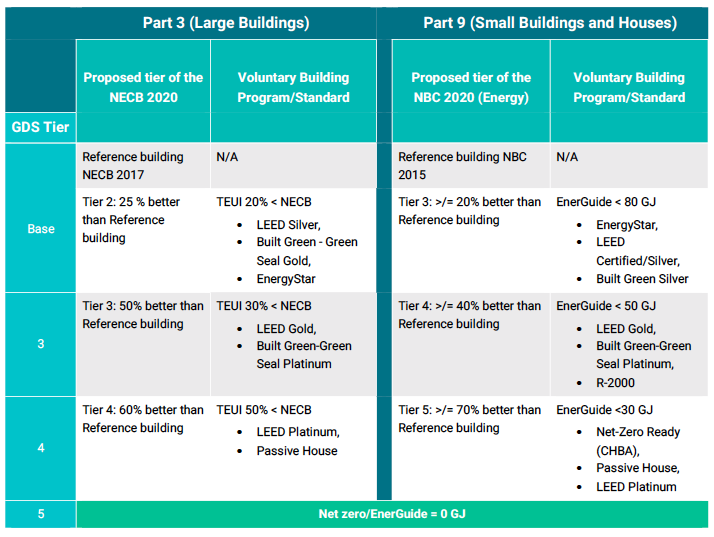Green Development Standards
Helping municipalities act now to increase efficiency in the buildings sector- Green Development Standards (GDS) can be used to create incentives or reduce barriers to developments that deliver environmental, social, and economic benefits.
- Municipalities seeking to advance climate action can use Green Development Standards to prepare the building sector, and the workforce, to deliver high-performance buildings at scale.
- Green Development Standards show senior governments that Canadian municipalities want immediate action when it comes to more stringent building energy standards.
Over 500 Canadian municipalities have declared a climate emergency and are now seeking ways to act on those declarations, this includes immediately improving the energy performance of new buildings. As these communities await the delayed proposed 2020 model codes, Green Development Standards (GDS) can act as a low-cost, effective way to act on their declarations.
Aligning their GDS with the proposed 2020 model codes, and taking a regional approach to GDS, can help municipalities prepare their local buildings sector for Canada’s net-zero economy while capturing community benefits such as good local jobs and healthy, comfortable, and resilient buildings for all. And, as the delayed proposed 2020 model codes come into action, GDS can support the market’s acceleration from lower tiers of the Code thereby helping to ensure that the market is able to advance towards higher tiers within a wider geography and the intended timeframe.
What are Green Development Standards?
Through the planning process, the municipality can use GDS to create incentives or reduce barriers to developments that deliver social and economic benefits, as well as prepare the local market for higher levels of building energy performance. This includes ensuring that new buildings in their community deliver levels of building energy performance beyond the minimum standards of the provincially/territorially adopted building code.
GDS enable municipalities to quickly reduce energy waste and building emissions in the built environment and are a key accelerant that prepares the building sector, and the workforce, to deliver high-performance buildings at scale. They also signal to senior governments that Canadian municipalities demand more stringent building energy standards than those required by the national model codes system.
Three approaches to a Green Development Standard
Three common approaches to GDS have emerged that municipalities can use. From most effective to least effective these are: a mandatory tiered approach, incentives-based approach, and a checklist or menu approach. Each can be used individually or in combination to encourage better building energy performance through GDS.
A mandatory tiered approach to reducing energy waste and emissions
The most effective GDS framework to reduce energy waste and emissions is the step and cap mechanism or tiered approach. Similar to the gold standard of GDS, the Toronto Green Standard, a tiered approach is based on a series of progressive green development measures. Each tier seeks a higher level of energy performance and emissions reductions. After a set period, the minimum mandatory requirement is updated, and the second tier now becomes the mandatory minimum.
The tiered approach seeks continuous improvements on energy reduction targets. It also encourages the voluntary uptake of higher tiered performance measures (Tier 3 and above) through various financial mechanisms or incentives. A tiered approach can be aligned with the tiers of the proposed 2020 model codes (see Table 1) will help to better prepare local markets for net-zero building codes tier advancements into the future.
Incentives can act as a bridge to a mandatory tiered approach
While not as effective as a mandatory tiered approach, Community Improvement Incentives offer municipalities a framework to induce higher levels of building performance. This framework uses incentives, combined with a series of progressive building performance targets. Incentives can include grants, loans, refunds, fee exemptions, tax increment rebates, density bonusing, financing or other incentives to assist project proponents, subject to available funding.
Incentives are often used by communities to pull developers towards higher levels of building energy performance. Incentives can also be aligned with the tiers of the proposed 2020 NECB/NBC (see Table 1). The key to encouraging high levels of uptake using incentives is ensuring that those incentives are proportionate to the incremental costs of exceeding the minimum standard for building energy performance.
Checklists or menus can be effective, if they emphasize energy and emissions
A GDS Evaluation Checklist that is included in subdivision and site plan agreements is another way for municipalities to encourage better building energy performance. The checklist’s menu-like layout provides a flexible point system where each sustainable design feature is assigned a specific number of points. This provides developers/builders the opportunity to choose features that best meet their needs, as long as it meets the minimum GDS point requirement set out by the municipality.
By itself, this approach must carefully balance energy and emissions with other sustainability features to ensure building energy performance targets are achieved. However, menus or checklists can be combined with a tiered approach where the tiers set a series of mandatory base targets while developers can select additional measures from the checklist to top up incentives.
GDS and Incentives are effective in supporting better building performance
- GDS and Incentives allow municipalities to prepare their local markets for the future adoption of tiered codes and NZE/NZEr standards.
- Each act as a catalyst in the local building sector to voluntarily meet net zero levels of energy/emissions from new buildings before provincial building codes are available.
- They provide education and training supports to increase the local understanding and capacity to construct high performance new buildings.
- They support municipal energy efficiency targets and GHG emission reduction targets.
- They offer municipalities a low-cost means to influence their community’s built environment through input in the design/permitting and post construction stages of new development.
Best practices
Align tiers of Green Development Standards with the upper tiers of the propose 2020 NECB/NBC
GDS are most effective when mandatory, standardized, prescriptive, consistent and when they incentivize upper tiers.
Encourage uptake through incentives
Provide meaningful incentives for those who choose to go beyond code minimums, including incentives for feasibility studies, partial development charge rebates, density bonuses or expedited permitting.
Emphasize energy and emissions
Higher performing buildings feature a number of measures intended to reduce energy waste and emissions. This means incentives must emphasize higher quality doors and windows, increased insulation, zero-carbon heating/cooling and hot water systems, and achieve high-levels of airtightness and balanced ventilation.
Provide resources for compliance and verification
Few resources are currently dedicated to promoting compliance with building energy improvement measures and, if compliance rates are low, GDS will not result in the expected energy savings, even if widely adopted.
Municipalities must plan to conduct verification of building energy performance to ensure buildings perform as designed. This includes increased training for building and inspection officials as well as linking robust compliance reporting to any potential funding arrangements.
Take a regional approach
Municipalities can amplify their building sector’s efforts and better prepare their workforce for the net-zero economy while also reducing leakage of construction activity to neighbouring jurisdictions by taking a regional approach.
Approximate GDS Alignment with the National Energy Code for Buildings (large buildings), the National Building Code (houses and small buildings) and leading voluntary standards

*NBC 2020 Tier 2 >/=10% omitted.
GDS deliver immediate action
A quarter of the homes and buildings we will live and work in by 2030 have yet to be constructed. This means we need to take urgent action today in order to avoid locked-in inefficiencies and emissions. A natural place to start is by ensuring all new buildings are highly energy efficient and zero-carbon. GDS are one of the key approaches that municipalities can use to deliver immediate benefits and prepare for Canada’s long-term clean-economy growth.

